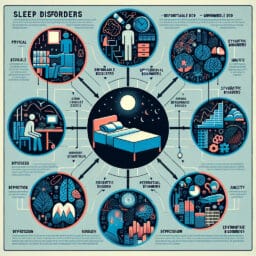
Understanding Hypersomnia: Definition, Causes, and Treatments
Table of Contents
- Introduction
- Definition of Hypersomnia
- Causes of Hypersomnia
- Symptoms of Hypersomnia
- Diagnosis of Hypersomnia
- Treatment of Hypersomnia
- Conclusion
- Frequently Asked Questions
Introduction
Hypersomnia, also known as idiopathic hypersomnia, is a sleep disorder characterized by persistent excessive sleepiness. This condition can significantly impact work life, social life and home life, making it crucial to improve sleep quality for those affected. Unlike the peaceful sleeping environment most of us enjoy, individuals with hypersomnia feel extremely sleepy throughout the day and may involuntarily fall asleep during daily activities despite having good nighttime sleep. The root cause varies; it might be an underlying neurological disorder or could be linked to other medical conditions such as chronic diseases including COPD asthma obstructive sleep apnea. Recognizing symptoms early – like daytime naps not providing relief from tiredness or memory problems – can lead to timely diagnosis using tools like the Epworth Sleepiness Scale or multiple sleep latency test (MSLT). Treatments include medications and non-drug options which are tailored according to individual needs to minimize side effects and ensure a better quality of life.
Definition of Hypersomnia
Living with excessive sleepiness can be challenging as it affects every aspect of life, from work and social engagements to seemingly simple tasks like reading a book or watching a movie. Hypersomnia, or idiopathic hypersomnia, is a puzzling medical condition that plunges individuals into this state of constant fatigue, despite getting good sleep at night. This isn’t your typical grogginess after a late-night binge-watching session; these individuals struggle to stay awake during the day, often falling asleep involuntarily in the middle of activities. However, unlike conditions such as Kleine-Levin Syndrome where patients may feel refreshed after long daytime naps, those with hypersomnia feel sleepy yet agitated as their naps fail to alleviate their tiredness.
Contrary to popular belief, hypersomnia is not simply extreme laziness or lack of motivation. It’s an actual sleep disorder recognized by leading bodies like the American Academy of Sleep Medicine and requires appropriate intervention for symptom management. Interestingly enough, this disorder varies greatly from other sleep disorders such as sleep apnea where interrupted breathing disrupts nighttime rest. With hypersomnia, there’s no issue with night-time slumber quality; the excessive daytime sleepiness stems from some underlying neurological disorders or could also be secondary to other medical conditions including COPD asthma obstructive sleep apnea.
Medical professionals rely on tools like Epworth Sleepiness Scale and Multiple Sleep Latency Test (MSLT) for diagnosis while emphasizing lifestyle modifications like avoiding alcohol and maintaining a consistent sleep schedule alongside pharmacological interventions for treatment efficacy.
Causes of Hypersomnia
Surprisingly, hypersomnia isn’t just about sleeping excessively; it’s a multifaceted sleep disorder. It’s often tied to genetic and lifestyle factors, as well as underlying health conditions. This excessive daytime sleepiness can be perplexing for both the individual suffering from it and those around them. Research indicates that some individuals may have a genetic predisposition towards idiopathic hypersomnia, making them more susceptible to its symptoms such as feeling extremely sleepy throughout the day and persistently struggling with memory problems, despite achieving good quality nighttime sleep.
Lifestyle factors also play an integral role in managing or exacerbating this condition. For instance, avoiding alcohol is advised because of its potential interference with sleep medicine and overall sleep quality. Besides these factors, secondary hypersomnia is often associated with other medical conditions such as neurological disorders or sleep apnea.
Additionally, maintaining a consistent schedule supplemented by brief daytime naps might alleviate the excessive fatigue experienced during the day but doesn’t always provide relief from ongoing tiredness. As part of diagnosis process at sleep disorders clinic, medical professionals typically employ tools like Epworth Sleepiness Scale and Multiple Sleep Latency Test (MSLT), while also encouraging patients to maintain a detailed ‘sleep diary’.
Remember that effective treatment takes into account individual need encompassing both medications and non-drug options for improved management of symptoms while minimizing side effects which ultimately enhances patient’s work life social life home life balance.
| Cause/Contributing Factor | Description |
|---|---|
| Genetic Predisposition | Some individuals may have a genetic predisposition towards idiopathic hypersomnia which makes them more susceptible to its symptoms. |
| Lifestyle Factors | Behavioral choices such as alcohol consumption can interfere with sleep medicine and overall sleep quality, exacerbating the condition. |
| Underlying Health Conditions | Secondary hypersomnia is often associated with other medical conditions such as neurological disorders or sleep apnea. |
| Inconsistent Sleep Schedule | Maintaining a consistent schedule supplemented by brief daytime naps might alleviate the excessive fatigue experienced during the day but doesn’t always provide relief from ongoing tiredness. |
| Diagnostic Tools | Epworth Sleepiness Scale and Multiple Sleep Latency Test (MSLT) are typically used for diagnosis, along with maintaining a detailed ‘sleep diary’. |
| Treatment Approach | Effective treatment takes into account individual need encompassing both medications and non-drug options for improved management of symptoms while minimizing side effects. |
Symptoms of Hypersomnia
Did you know that idiopathic hypersomnia, a perplexing sleep disorder, often conceals itself behind what appears to be an insatiable desire for daytime naps? This isn’t mere laziness or lack of motivation. It’s a deep-seated condition characterized by excessive sleepiness and a constant feeling of fatigue that persists despite getting good quality nighttime sleep. The distinguishing factor is that individuals with this condition might fall asleep involuntarily during the day yet feel extremely sleepy and agitated since these naps do not provide relief from their tiredness. These symptoms can severely affect work life, social life, and home life in ways we may not immediately comprehend. Imagine struggling to stay focused on your tasks at hand or constantly battling memory problems due to fragmented sleep patterns! Keep in mind the crucial role lifestyle factors play too; avoiding alcohol is recommended as it could interfere with overall sleep quality and certain sleep medicines prescribed for treatment. Diagnosis typically involves tools such as the Epworth Sleepiness Scale or Multiple Sleep Latency Test (MSLT) administered at a sleep disorders clinic besides keeping track of sleeping habits via a ‘sleep diary’. An underlying neurological disorder could also be at play here causing secondary hypersomnia which further complicates matters by mimicking other medical conditions like mood disorders or even obstructive sleep apnea! Such complex interplay between various factors underscores the need for tailored treatments including medications and non-drug options aimed at managing this pan hypothalamic disorder while minimizing side effects ensuring an improved quality of life.
| Symptoms of Hypersomnia | |
|---|---|
| Main Features | Excessive sleepiness, constant feeling of fatigue, involuntary sleep during the day, lack of relief from tiredness after naps |
| Effect on Life | Affects work, social, and home life due to difficulty in staying focused and memory problems |
| Lifestyle Factors | Avoiding alcohol as it can interfere with sleep quality, mindful of sleep medicines prescribed |
| Diagnosis | Epworth Sleepiness Scale, Multiple Sleep Latency Test (MSLT), Sleep diary, examination in sleep disorders clinic |
| Complexities | Can be secondary to an underlying neurological disorder, can mimic other medical conditions like mood disorders or obstructive sleep apnea |
| Treatment | Tailored treatments including medications and non-drug options aimed at managing the disorder and minimizing side effects |
| Image | |
Diagnosis of Hypersomnia
A precise diagnosis of hypersomnia, often camouflaged by its elusive symptoms like excessive sleepiness and memory problems, is crucial since it affects the work-life balance, social interactions, and home life of those afflicted. It’s not just about feeling sleepy or requiring daytime naps; this puzzling medical condition involves underlying neurological disorders, possibly secondary to other diseases such as COPD asthma obstructive sleep apnea. Initial evaluation at a sleep disorders clinic includes tools like the Epworth Sleepiness Scale and the Multiple Sleep Latency Test (MSLT) that help gauge the depth of this pan hypothalamic disorder. Patients are also encouraged to keep a detailed ‘sleep diary’ helping doctors unravel their unique sleep patterns. This careful examination differentiates hypersomnia from other similar conditions such as Kleine-Levin Syndrome where patients do feel refreshed after long daytime naps – unlike individuals with hypersomnia who continue feeling extremely sleepy despite good quality nighttime rest. Accurate diagnosis leads to tailored treatments offering relief both through medications and non-drug options whilst minimizing potential side effects – ultimately aiming for an improved quality of life for patients.
Treatment of Hypersomnia
Insight into idiopathic hypersomnia goes beyond the realm of mere excessive sleepiness. This medical condition, in fact, presents a Pandora’s box of challenges affecting work life balance, social interactions and home life. Indeed, living with constant fatigue that perseveres despite good sleep at night can be disorientating for its sufferers. Having an arsenal of effective treatments is hence crucial to navigate this maze and improve sleep quality while managing side effects. One key weapon against this perplexing condition lies in medications tailored to the individual’s needs. These range from stimulants like Modafinil to antidepressants and sodium oxybate, each chosen carefully by the clinician based on the patient’s specific symptoms and underlying conditions.
In parallel to these pharmacological interventions, behavioral therapy plays a significant role in mitigating symptoms of hypersomnia; techniques such as cognitive-behavioral therapy (CBT) help individuals alter their thoughts and behaviors related to sleep which can bring about substantial relief.
Additionally, lifestyle modifications are an integral part of managing this disorder—maintaining a consistent sleeping schedule supplemented by brief daytime naps may alleviate feelings of excessive daytime sleepiness. Avoiding alcohol is also advised due to its potential interference with certain medicines used for treatment.
All these approaches converge towards one goal – allowing those afflicted by hypersomnia or other similar conditions such as Kleine-Levin syndrome or secondary hypersomnia stemming from neurological disorders or obstructive sleep apnea among others – to regain control over their lives and resume their daily activities unhampered by unwarranted drowsiness or memory problems.
Conclusion
Living with idiopathic hypersomnia, characterized by excessive sleepiness and a persistent drowsy state, proves challenging as it disrupts work-life balance, social interactions and home life. This perplexing medical condition is not simply ‘feeling sleepy’. Despite achieving good sleep at night, individuals afflicted with this disorder involuntarily fall asleep during daytime activities and continuously feel extremely sleepy yet agitated as daytime naps do not alleviate their fatigue. Diagnosis involves tools like the Epworth Sleepiness Scale and Multiple Sleep Latency Test (MSLT) performed in a sleep disorders clinic. Treatment encompasses individually tailored medications along with non-drug options, aiming to improve sleep quality while minimizing side effects. Importantly, an early diagnosis can lead to efficient management of this condition thereby enhancing the quality of life for those affected.



